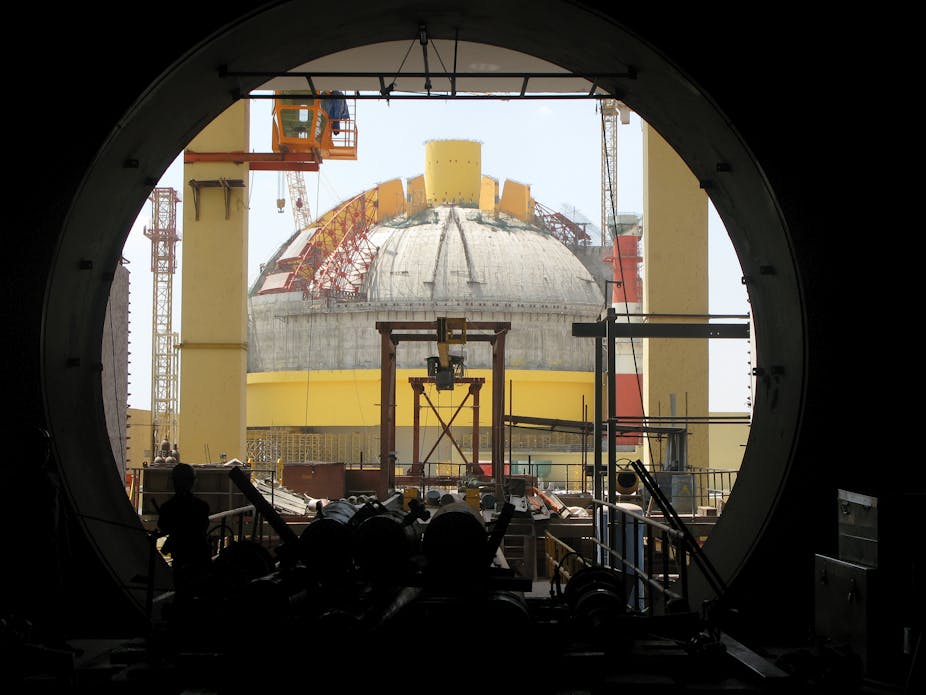Australia’s prime minister Tony Abbott is set to sign a deal with India that will allow the export of uranium to the country.
There are concerns that some of the uranium will be used to produce nuclear weapons in India. It’s not likely, though the possibility remains. Critics have also pointed to poor regulation and the lack of transparency in India’s nuclear industry.
But Australia can play a bigger role in improving India’s nuclear industry than just exporting uranium. It can also provide expertise in risk governance and communication.
It is still unclear how much uranium India will get, but Australia currently ships 500 tonnes a year to China, a country India seeks to catch up with.
Speculation that Australia seeks to make up for its ban on uranium exports to Russia are also unlikely. Less than 100 tonnes of uranium has been shipped to Russia since the 2007 bilateral agreement between the two countries.
Weapons concerns are overstated
The truth is that the nuclear industry, the world over, from the US and UK to Japan, is shrouded in secrecy and suffers from varying degrees of weak regulation.
But concerns over India’s nuclear weapons programme are also over-stated. India may not be a signatory to the Non-Proliferation Treaty, but it is a member of a number of other multi-lateral organisations including the World Association of Nuclear Operators and International Atomic Energy Agency.
India’s nuclear programme has also been historically more interested in advancing nuclear technology towards the thorium reactor, which (in theory) burns up plutonium and depleted uranium used in weapons.
Increasing transparency
More importantly, India’s nuclear industry today stands at a unique juncture of change, with gradually increasing transparency and eagerness to learn better approaches to risk management.
In 2008, the Indo-US deal separated India’s military nuclear programme from its civilian operations (including nuclear power stations). This meant that nuclear power stations are (on paper at least) no longer protected by the Official Secrets Act, opening the industry to international and domestic public scrutiny for the first time.
This separation also strengthened the 2005 Right to Information Act, which provides the legal right for Indian citizens to demand information from the government.
Then came the 2011 Fukushima nuclear disaster, which unleashed a second storm of public backlash over concerns about safety standards and the lack of an independent regulator.
This led to greater demands for transparency, from rural to urban society, aided by the Right to Information Act. It also brought forward the 2011 Nuclear Safety Regulatory Authority Bill meant to create a more independent regulator, outside the purview of the Atomic Energy Commission. The commission is the overarching government body that promotes nuclear power and therefore cannot be tasked with regulating its own subsidiaries.
In addition, for the first time, the government allowed the International Atomic Energy Agency to conduct a safety review of two atomic power plants in Rajasthan in September 2012.
Contrary to some critics, the enormity of the 2011 Fukushima disaster has not been lost on the Indian nuclear industry.
I interviewed senior nuclear executives in India after Fukushima and found an emphasis on scientific humility and the recognition that there is no “100% safe” guarantee. The possibility of an accident in India, therefore, cannot be discounted.
There was also talk of “producing ethics”, not just energy, and the need for the “social license to operate”, not just official licensing. More information about safety reports and research and development has been published on the websites of nuclear organisations, and nuclear scientists themselves have written more actively in newspapers and forums.
But these efforts have largely back-fired largely because of poor risk communication and deep-seated public distrust.
Australian natural disasters to Indian nuclear power
This is where Australia is poised to export more than just uranium, but knowledge and expertise.
Australia has had decades of experience in risk communication in disasters. Its history of disaster response to storms, floods and forest fires is full of good examples. The Emergency Services websites of the different states provide updated and useful information about impending disasters.
When Cyclone Yasi struck Townsville and Cairns in 2011, people were given early warnings and clear instructions. Most importantly, the then Prime Minister Gillard told affected communities that “all of Australia was thinking of” them moments before the storm hit the coast.
The trick, for an official, is to acknowledge and validate public fears and treat them as legitimate instead of downplaying them as irrational, then emphasise that this is a challenge shared by government and community This facilitates cooperation.
Nuclear disasters involve a different dynamic and India hasn’t experienced one, but the same principles apply and using the right language before disaster strikes is as important, if not more, in building trust and developing the right relationships with communities.
Australia also has good examples of industry engaging with the government and local communities in decision-making to produce better outcomes in environmental and safety regulation. This includes the pulp and paper, and LNG industries, where corporate decision went beyond compliance with regulation.
The Nuclear Power Corporation of India has similar examples. It volunteered for the Environment Stewardship Programme, which involved transforming the 5 kilometre sterilised zone around its nuclear power plants into conservation areas for flora and fauna. By raising the bar and extending this practice into areas of environmental regulation and safety, they can encourage other nuclear subsidiaries and contracting companies to do they same, or better.
But the industry still lacks expertise in public engagement and risk communication.
India’s nuclear industry is at a unique point of transition where there is both political will and industrial momentum to learn. Australia should capitalise on this rare opportunity to offer more than natural resources but knowledge that can contribute to a safer, more pro-active and more inclusive nuclear industry in India.

